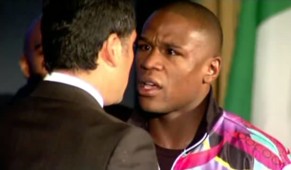 Michael Herron (M.I.C.): In boxing, and life in general, the chances you take can often be described as a risk/reward ratio. More often than not, we hear of prize fighters accepting or declining fights based on this concept. The fighters refer to this as being “smart businessmen”; but fans experience it as “frustration.” The most common and unfortunate outcome is that the fights the fans want to see are frequently not made because the fighters can’t agree that the risk matches the reward.
Michael Herron (M.I.C.): In boxing, and life in general, the chances you take can often be described as a risk/reward ratio. More often than not, we hear of prize fighters accepting or declining fights based on this concept. The fighters refer to this as being “smart businessmen”; but fans experience it as “frustration.” The most common and unfortunate outcome is that the fights the fans want to see are frequently not made because the fighters can’t agree that the risk matches the reward.
For a prize fighter, the best-case scenario is a low-risk, high-reward fight, or as they call it, “easy money.” An example of this would be Floyd Mayweather, Jr. vs. Henry Bruselles. These types of fights may line their pockets, but will not enhance their legacy. A second scenario is the high-risk, high-reward contest, a.k.a., the “payday.” This occurs when a fighter accepts a challenge with a dangerous opponent, perhaps even as a tune-up, but with the guarantee of a big financial reward. There are many examples of this throughout boxing history; the clearest example would be the upcoming De La Hoya vs. Stevie Forbes contest. Finally, there is the high- risk, low- reward fight when fighters put it all on the line, enhancing their legacy but for minimal financial gain. The clearest example would be the Israel Vasquez vs. Raphael Marquez trilogy. I can go on about the risk/reward concept in terms of highs and lows indefinitely, but a more frequent ratio, medium risk/medium reward, is seldom discussed.
Boxing fans often wonder how certain fighters always seem to secure marquee matchups. Whether they win, lose, or draw, they are consistently selected to face the big names and top contenders. These are the medium- risk, medium- reward fighters. Fighters like Zab Judah, Rocky Juarez, Carlos Quintana, Ricardo Mayorga, Fernando Vargas, Carlos Baldomir–you know them, you may even love them; what they have in common is that they will face nearly any opponent, regardless of how dangerous, for medium- and sometimes low-reward. Another commonality is, though they are big names themselves, they do not operate like the elites of the sport, or should I say, the “businessmen” of the sport. They are more willing to accept the challenge and gain the exposure than to lose the opportunity at the negotiation table. As a result, they are commonly featured opponents, for they can deliver a good challenge, engender a moderate payday, garner fan approval, and enhance a fighter’s legacy.
So let’s look at some of these fighters up close: Quintana has faced Joel Julio, Miguel Cotto, and Paul Williams. Zab Judah has battled Kosta Tsyzu, Cory Spinks, Floyd Mayweather, Jr., Miguel Cotto, and is currently scheduled to face Shane Mosley. Vargas and Mayorga have both fought the elites of the their divisions, including each other, and Juarez has been in with Marco Antonio Barrera and Juan Manuel Marquez, and may soon be facing Jorge Barrios. “There are of course many fighters that deserve recognition, but I list these fighters in light of their recent activity in the ring.”
Conceivably, medium- risk/ medium- reward is not the most endearing way to describe a fighter’s worth; and it is likely not a new perception. Maybe this is the class of fighter that boxing pundits have always referred to as gatekeepers or simply contenders. What is clear, however, is that the life-blood of boxing does not reside in the self-centered elites, but with the fighters who are cast as medium risk, accept medium rewards, but deliver large to this great sport.